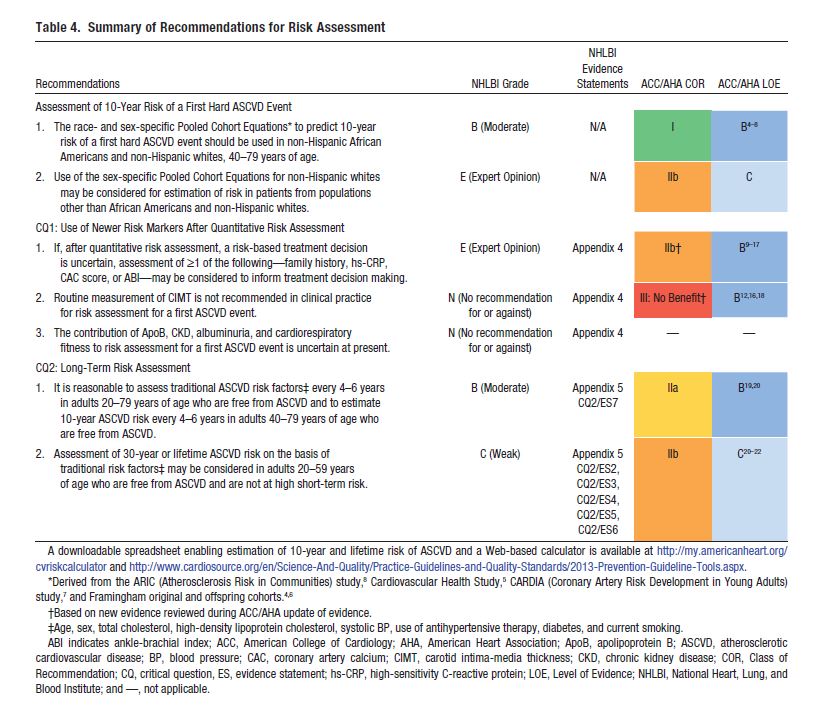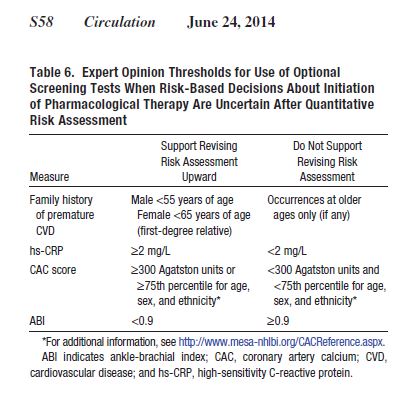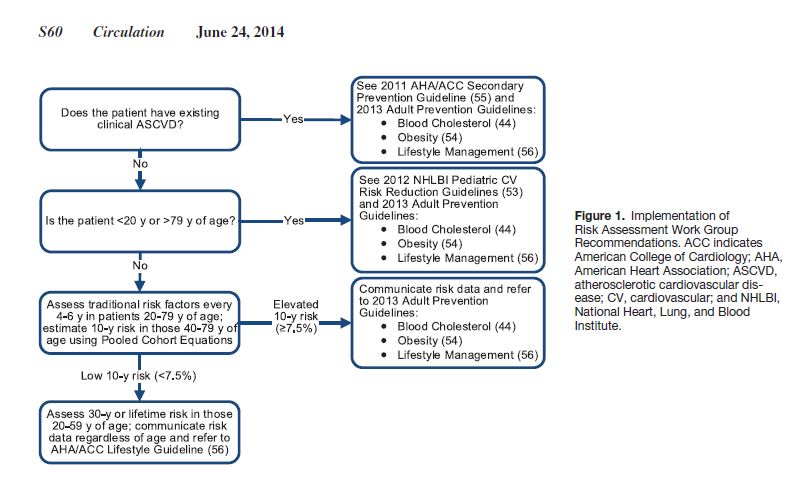The following is from the ACC website link:
The ACC and the American Heart Association (AHA), in collaboration with the National Heart, Lung, and Blood Institute and other specialty societies, have released four guidelines focused on the assessment of cardiovascular risk, lifestyle modifications to reduce cardiovascular risk and management of elevated blood cholesterol and body weight in adults.
In order to support the implementation of these guidelines the ACC and AHA have jointly published a new mobile application (app).
The ASCVD Risk Estimator application helps health care providers and patients estimate 10-year and lifetime risks for atherosclerotic cardiovascular disease (ASCVD) using the Pooled Cohort Equations and lifetime risk prediction tools. The ASCVD Risk Estimator provides easy access to recommendations specific to calculated risk estimates. Additionally, the app includes readily accessible guideline reference information for both providers and patients related to therapy, monitoring, and lifestyle.
The app is available on both iTunes (iPhones, iPads) and Google Play (Galaxy, Nexus, other Android devices). Use the links below from your mobile device to download the app.
The following are excerpts from Reference (1):
If you or your patient are unsure about whether the patient should proceed with further risk modification after the risk evaluation, you and the patient can use the additional information below to help in the decision making.
A suggested approach for incorporating these recommendations into clinical practice is shown in Figure 1. For patients 20 to 79 years of age who are free from clinical ASCVD, the first step is to assess ASCVD risk factors. Although it is reasonable to assess ASCVD risk factors in individuals younger or older than this age range, limitations of available data prevented the development of robust risk assessment algorithms in those populations. Hence, for patients outside this age range, providers should refer to applicable clinical practice guidelines (ie, pediatric53 and adult primary prevention guidelines.44,54,56 Risk assessment should be repeated every 4 to 6 years in persons who are found to be at low 10-year risk (<7.5%). Beginning at age 40 years, formal estimation of the absolute 10-year risk of ASCVD is recommended.20,21 Long-term or lifetime risk estimation is recommended for all persons who are between 20 and 39 years of age and for those between 40 and 59 years of age who are determined to be at low 10-year risk (<7.5%). As shown in Figure 1, all patients should receive applicable risk information and appropriate lifestyle counseling. The 10-year risk estimates provided by the new Pooled Cohort Equations differ from those generated by the Adult Treatment Panel III algorithm in several respects,24 as discussed in detail in the Full Work Group Report supplement. To summarize, on the basis of the risk estimation algorithm recommended by Adult Treatment Panel III, approximately 31.9% of the ASCVD-free, nonpregnant US population between 40 and 79 years of age have a 10-year risk of a first hard CHD event of at least 10% or have diabetes. On the basis of the new Pooled Cohort Equations described here, approximately 32.9% have a 10-year risk of a first hard ASCVD of at least 7.5%. The outcomes and thresholds of these 2 approaches are different, but the overlap of these 2 means of defining high-risk groups is substantial, at roughly 75%. Nonetheless, these important differences make simple linear conversions imprecise. We recommend that healthcare organizations convert to these new Pooled Cohort Equations as soon as practical (Appendix 7). A Web-based application enabling estimation of 10-year and lifetime risk of ASCVD is available at https://my.americanheart.org/cvriskcalculator and https://www.cardiosource.org/en/Science-And-Quality/Practice-Guidelines-and-Quality-Standards/2013-Prevention-Guideline-Tools.aspx.
Resources:
ACC/AHA PREVENTION GUIDELINE
2013 ACC/AHA Guideline on the Assessment of Cardiovascular Risk
A Report of the American College of Cardiology/American Heart Association Task Force on Practice Guidelines [PubMed Abstract] [Full Text HTML – This link is said to contain the article with the corrections listed below] [Download PDF]
Corrections to the original 2013 ACC/AHA Guideline on the Assessment of Cardiovascular Risk







